Top 10 AI Tools for Pipeline Acceleration in 2025
One study from Salesforce reveals that sales reps spend nearly 70% of their time on non-selling tasks that slow down pipeline progression.
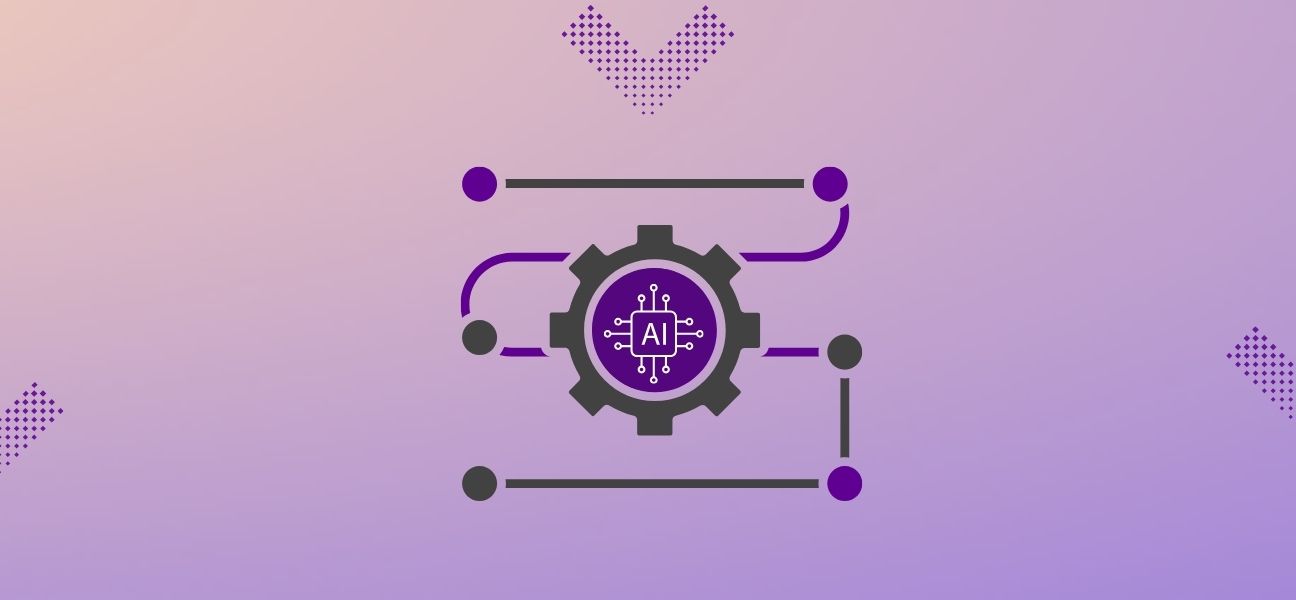
Modern sales teams face a paradox: even with plenty of leads, many pipelines stall before closing. Manual prioritization, slow follow-ups, and poor visibility cause leaks and lost momentum. One study from Salesforce reveals that sales reps spend nearly 70% of their time on non-selling tasks that slow down pipeline progression.
AI is changing that. Instead of letting opportunities stagnate, AI tools now intervene proactively, scoring, nurturing, alerting, and cleaning the pipeline. In this blog, we’ll explore how “AI tools for pipeline acceleration” help sales teams move deals faster, maintain quality, and generate more predictable revenue. We’ll also cover core use cases, metrics, and top tools that play a critical role in maintaining pipeline velocity.
Why Pipeline Acceleration Matters (Especially in Enterprise & RFP-Driven Sales)
Even a robust pipeline means little if deals don’t progress. Pipeline velocity, or how fast deals move through stages, is critical for maintaining deal momentum, forecasting revenue, and avoiding waste. In enterprise contexts, long sales cycles and demanding procurement processes exacerbate risk: each delay, misalignment, or proposal error can erode trust and derail the deal. Pipeline velocity, or how fast deals move through stages, is critical for maintaining deal momentum, forecasting revenue, and avoiding waste.
Traditional methods like static spreadsheets, manual follow-up cadences, and reactive deal management lack the agility to catch problems early or guide sellers intelligently. Pipeline acceleration via AI helps by:
- Surfacing bottlenecks early: Leverage data across calls, emails, and deal stages to highlight which deals are losing steam or need intervention.
- Prioritizing attention: AI models rank deals by conversion probability or risk, ensuring sellers focus where impact is highest.
- Enabling smarter automation: Trigger-based nudges, re-engagement of cold leads, and content suggestions keep the pipeline moving without manual effort.
- Bridging downstream friction: In sales cycles with RFPs or proposals, delays or errors in final responses often become the slowest stage. AI that accelerates proposals helps preserve the momentum earned earlier.
Pipeline acceleration doesn’t just close deals faster; it preserves the energy, alignment, and narrative built in earlier stages, so that by the time an RFP or contract enters the picture, the deal doesn’t stall.
Core Use Cases: How AI Accelerates Pipeline
AI isn’t just another layer of automation; it adds intelligence to every stage of pipeline management. By embedding predictive analytics and contextual recommendations into daily workflows, sales teams gain the ability to move deals forward with less friction. Here are the most impactful use cases:
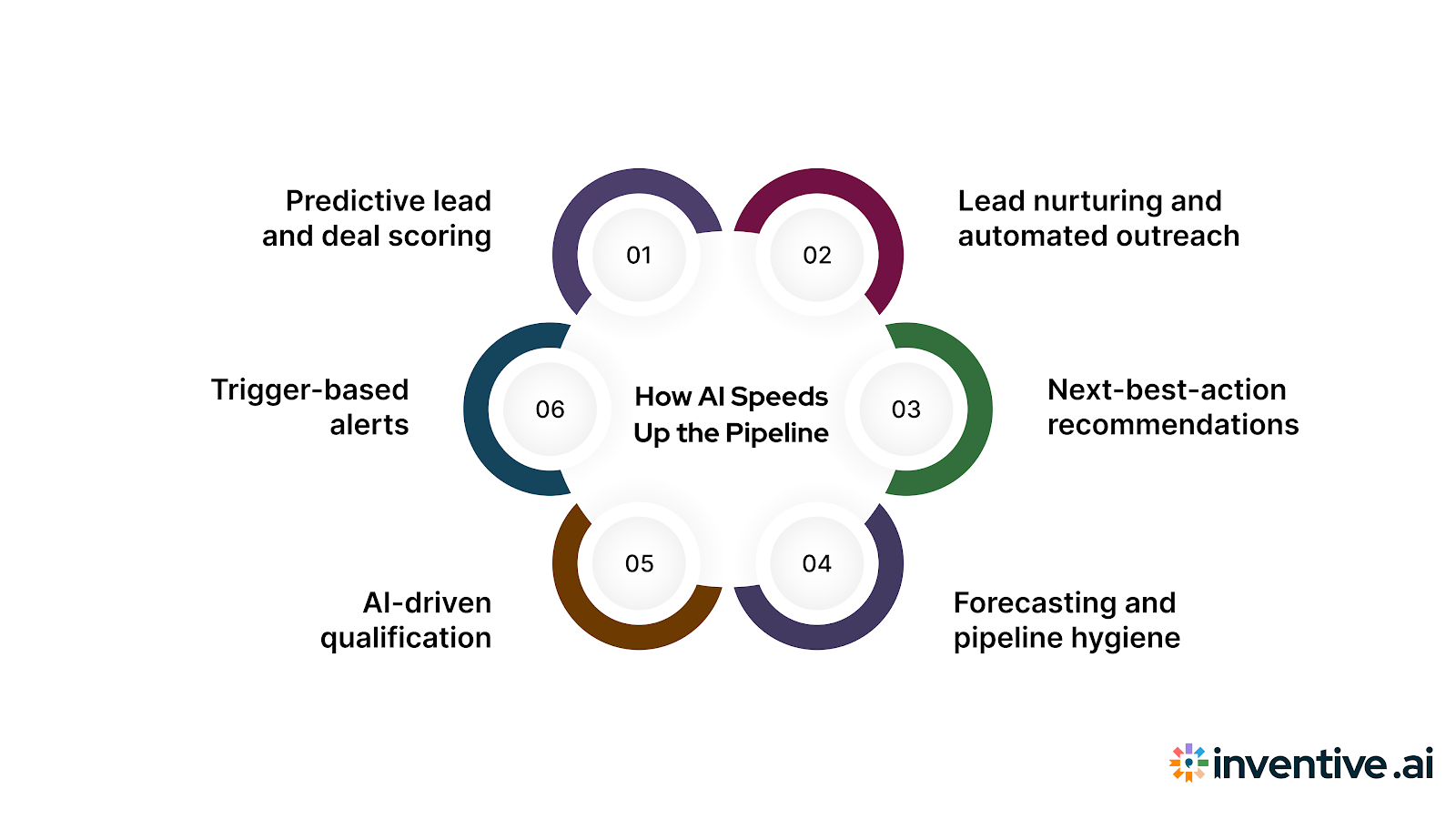
1. Predictive lead and deal scoring
Instead of relying on gut instinct or arbitrary qualification rules, AI uses intent and engagement intelligence to prioritise opportunities. Modern scoring models go beyond static win/loss ratios; they analyse email sentiment, call transcripts, and conversational cues to understand buyer readiness. This helps sales teams focus on deals that show genuine purchase intent rather than just historical fit, resulting in cleaner, faster-moving pipelines.
2. Intelligent Lead Nurturing and Deal Momentum
AI now links nurturing, forecasting, and next-best-action into a single, self-optimising workflow. Instead of tracking superficial metrics like opens or clicks, modern systems analyse real conversations — sales-call transcripts, email tone, and meeting summaries, to understand intent and sentiment. Based on these insights, they recommend the next logical move: sending a case study that addresses a buyer’s concern, looping in a technical expert, or re-engaging a stakeholder who’s gone quiet.
At the same time, the same intelligence layer forecasts deal health in real-time, flagging opportunities that show declining engagement or misaligned intent before they stall. This constant loop of “listen, predict, act” keeps the pipeline active, accurate, and moving, turning what used to be separate tasks of nurturing, forecasting, and follow-up into one continuous acceleration engine.
3. AI-driven qualification and triage
Sales development reps (SDRs) often waste hours chasing unqualified leads. AI-driven qualification tools assess readiness, budget, and intent signals early, routing only high-quality opportunities to account executives. This creates a cleaner, faster-moving pipeline.
4. Trigger-based alerts and deal reactivation
AI scans for key buying signals, budget approvals, competitor activity, or re-engagement from dormant accounts and alerts reps in real time. By reactivating stalled opportunities at the right moment, sellers recover the pipeline that would otherwise be lost.
Related: Guide to RFP Response Process Flow Chart
Tangible Benefits & Metrics to Watch
Pipeline acceleration is only meaningful if it translates into measurable business outcomes. AI-driven pipeline tools deliver impact across four key dimensions that CROs, VPs of Sales, and operations teams track closely:
1. Higher conversion rates and win rates
AI ensures that sales teams focus on high-probability opportunities, tailor engagement to buyer priorities, and eliminate errors in proposals. According to Bain, companies using AI effectively in sales processes can see win rate improvements of 30–50%.
2. Shorter sales cycles
By automating follow-ups, surfacing next-best actions, and speeding proposal responses, AI reduces deal cycle time. Research from McKinsey indicates that companies adopting AI for sales productivity cut cycle times by up to 20–30% in complex B2B deals.
3. Increased pipeline velocity
Pipeline velocity, the value of opportunities multiplied by conversion rate and divided by sales cycle length, improves when deals move smoothly through stages. With AI reducing bottlenecks, sales leaders see both greater predictability and higher throughput.
4. Improved pipeline coverage
AI qualification filters out unfit deals earlier, ensuring that SDR and AE bandwidth is spent on opportunities with real buying intent. This not only improves efficiency but also creates healthier coverage ratios, giving leaders confidence in quarterly forecasts.
When leaders can tie pipeline health to metrics like win rate, cycle length, and velocity, the case for AI goes beyond efficiency; it becomes a revenue growth engine.
Accelerate your pipeline with grounded AI.
Respond to RFPs 10× faster with verified, evaluator-aligned drafts built for enterprise sales.
Related: How to Improve Your RFP Win Rates
Top 10 AI Tools for Pipeline Acceleration in 2025
AI tools for pipeline acceleration work across different stages of the sales cycle - from prospecting and engagement to proposal automation and forecasting. While some platforms focus on generating higher-quality leads or automating outreach, others enhance deal visibility, sales intelligence, or late-stage proposal turnaround. Below is a curated list of tools that reflect the most relevant categories shaping pipeline velocity in 2025, combining predictive insights, AI-driven engagement, and automation to help revenue teams maintain consistent deal flow.
1. Inventive AI

Gartner Rating: 5/5
Inventive AI is an advanced, AI-powered proposal and RFP automation platform designed to eliminate one of the biggest pipeline slowdowns, the late-stage response bottleneck. In most enterprise sales cycles, deals stall not because of a lack of leads, but because proposal creation, compliance reviews, and evaluator alignment take too long. Inventive AI fixes that by turning RFPs and proposals into fast, insight-driven outputs that maintain the deal’s momentum all the way to close.
Unlike generic AI tools, Inventive AI connects directly to the systems sales and presales teams already use, CRM, SharePoint, Notion, and Slack, to move deals faster without losing accuracy or compliance. Its precision drafting, contextual alignment, and analytics capabilities ensure that once opportunities reach the RFP stage, they continue advancing instead of stalling.
Key Features
- Grounded AI responses: Generates citation-backed proposal content from verified internal sources with 95% accuracy and 0% hallucination, cutting drafting time by up to 90%.
- Win Themes Engine: Maps every response to evaluator scoring rubrics, ensuring proposals stay strategically aligned with buyer priorities and improve late-stage conversion.
- Context Engine: Reads discovery notes, deal data, and RFP language to produce contextually relevant drafts that reflect the exact buyer conversation, not just templates.
- AI-powered content governance: Flags outdated, duplicate, or conflicting proposal data automatically to prevent errors that slow approvals.
- Collaboration workspace: Centralises version tracking, SME input, and comments across functions, keeping all contributors aligned and speeding up internal reviews.
- Pipeline acceleration analytics: Tracks turnaround times, win-rate lift, and content performance to reveal where proposals gain or lose velocity in the deal cycle.
Pros
- Eliminates RFP and proposal bottlenecks that slow late-stage deals.
- Ensures proposals mirror buyer context, preserving deal momentum.
- Integrates with CRMs and collaboration systems for continuous workflow.
- Grounded, citation-based AI eliminates rework and compliance risk.
Cons
- Limited analytics available for enterprise-level reporting.
Pricing
Usage-based plan that scales with your team’s RFP throughput and activity levels.
Best for
Mid-market and enterprise teams managing complex RFPs, DDQs, and proposals that directly affect pipeline velocity and win rates.
2. Cognism

Gartner Rating: 4.4/5
Cognism is a B2B data enrichment and lead intelligence platform that focuses on sourcing compliant, verified contact data to enhance the quality of top-of-funnel opportunities.
Key features
- AI-driven company and contact enrichment.
- Intent data and buying signal tracking to identify in-market prospects.
- Data verification through its proprietary Diamond Data® system.
- CRM integration with Salesforce, HubSpot, and Outreach.
Pros
- Provides structured, GDPR-compliant prospect data.
- Improves SDR efficiency through accurate targeting.
Cons
- Primarily focused on enrichment, not engagement or automation.
- Limited customization for niche industries.
Pricing: Custom pricing; offered in Grow and Elevate plans.
Best for
Sales and marketing teams that require clean, compliant lead data to build healthier pipelines.
3. HubSpot Sales Hub
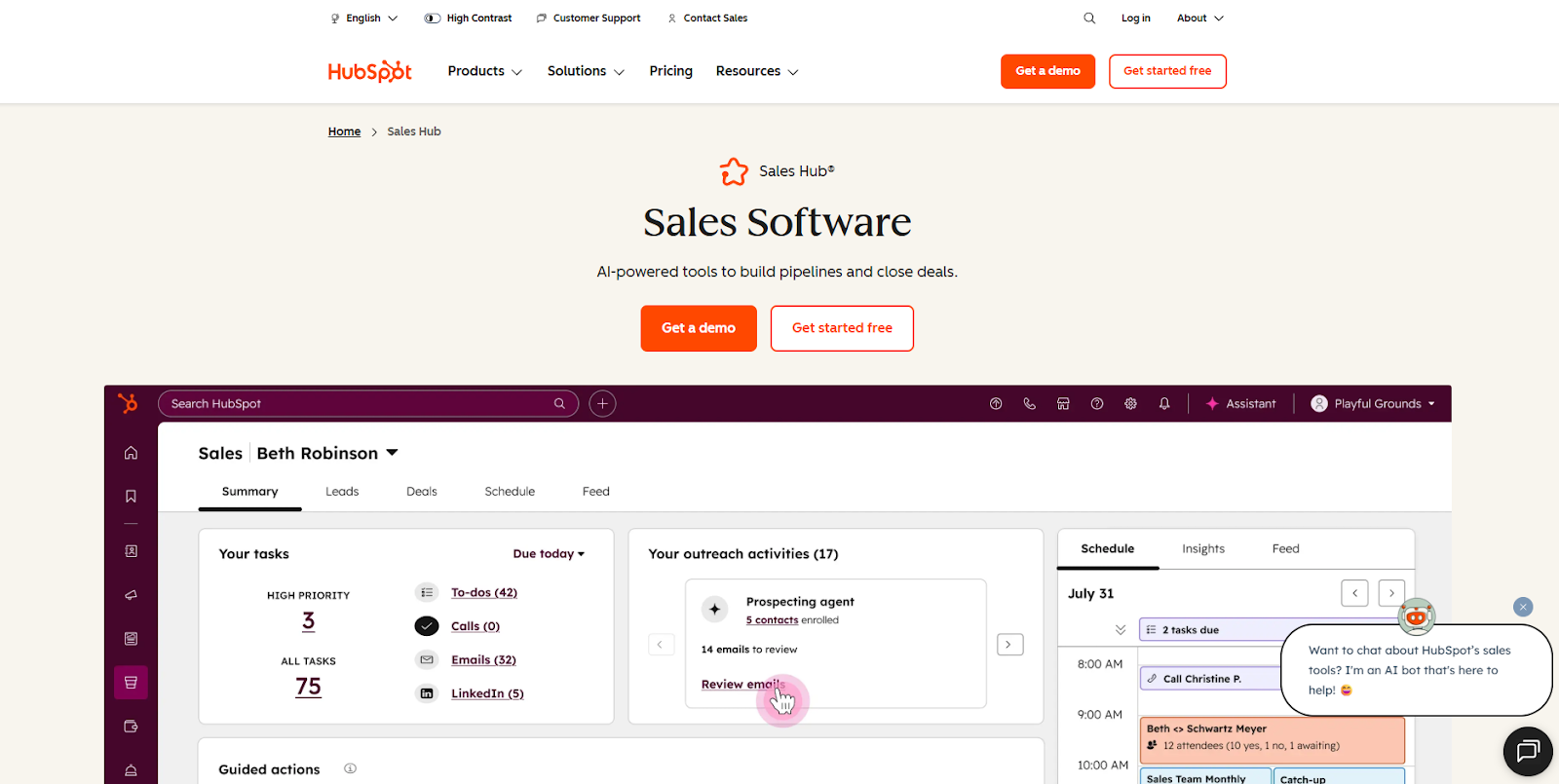
Gartner Rating: 4.4/5
HubSpot Sales Hub is a CRM suite designed to unify sales activities, automate follow-ups, and apply predictive lead scoring for better prioritization.
Key features
- Predictive lead scoring using behavioral and demographic inputs.
- Automated notifications for deal stage updates.
- Email tracking, meeting scheduling, and pipeline forecasting.
- Centralized deal dashboard for visibility.
Pros
- Consolidates outreach, scoring, and forecasting in one environment.
- Scales easily for growing sales teams.
Cons
- Predictive models are generic — limited adaptability for long-cycle enterprise deals
- Built-in automation works for basic follow-ups, but not for multi-stakeholder RFP or compliance workflows
- Scaling cross-regional or multi-product pipelines often leads to cluttered dashboards and visibility gaps
Pricing
Starter: $15/user/month; Professional: $90/user/month; Enterprise: $150/user/month.
Best for
Growing B2B teams seeking integrated CRM, pipeline visibility, and automation in one platform.
4. Overloop AI

Gartner Rating: N/A
Overloop AI is a sales automation platform that helps teams design and execute multi-channel outreach sequences using AI-generated personalization at scale.
Key features
- AI-generated outbound email and sequence creation.
- Multi-channel orchestration (email, LinkedIn, calls).
- Data filtering and sourcing for prospect targeting.
- Native CRM and deliverability integrations.
Pros
- Simplifies outreach workflow through automation.
- Reduces manual personalization effort.
Cons
- Analytics remain limited beyond top-of-funnel metrics.
- Requires frequent tuning to maintain deliverability and personalization.
- No built-in support for proposal or mid-funnel workflows.
Suggested Alternative: Inventive AI
Teams ready to move beyond outreach into full-cycle pipeline acceleration choose Inventive AI, which unifies proposal drafting, content governance, and deal analytics for faster progression.
Pricing
Credit-based pricing; custom plans based on volume and users.
Best for
Teams seeking scalable outbound automation with personalized touchpoints across multiple channels.
5. Gong.io

Gartner Rating: 4.7/5
Gong is a conversation intelligence platform that captures and analyzes customer interactions across calls, meetings, and emails to surface insights on deal health and performance.
Key features
- AI-powered transcription and conversation analysis.
- Detection of sentiment, objections, and competitor mentions.
- Deal dashboards highlighting engagement risks.
- Coaching analytics for sales and presales teams.
Pros
- Offers deep visibility into buyer conversations.
- Helps identify themes across successful deals.
Cons
- Offers observation only—no execution or drafting automation.
- Data sync issues can arise without strong CRM integration.
- Adds visibility but not measurable speed to proposal workflows.
Pricing: Custom pricing based on users and usage volume.
Best for
Mid-to-large sales organizations that need visibility into buyer behavior and conversation trends for better pipeline forecasting.
6. Fireflies.ai

Gartner Rating: N/A
Fireflies.ai is an AI meeting assistant that records, transcribes, and summarizes sales and customer calls, ensuring that key insights are documented and logged into connected systems.
Key features
- Automatic recording and transcription of meetings.
- AI-generated call summaries and searchable notes.
- Integration with CRM and collaboration tools such as Salesforce, HubSpot, and Slack.
- Multi-user access for shared visibility across teams.
Pros
- Reduces manual note-taking during meetings.
- Helps maintain accurate post-meeting records in CRM.
Cons
- Summaries may require manual review for complex discussions.
- Limited analytical depth beyond transcription and keyword search.
Pricing: Free plan available; paid plans start at $10 per user per month.
Best for
Sales teams that need automated call documentation to maintain meeting visibility and support pipeline follow-up accuracy.
7. Demostack
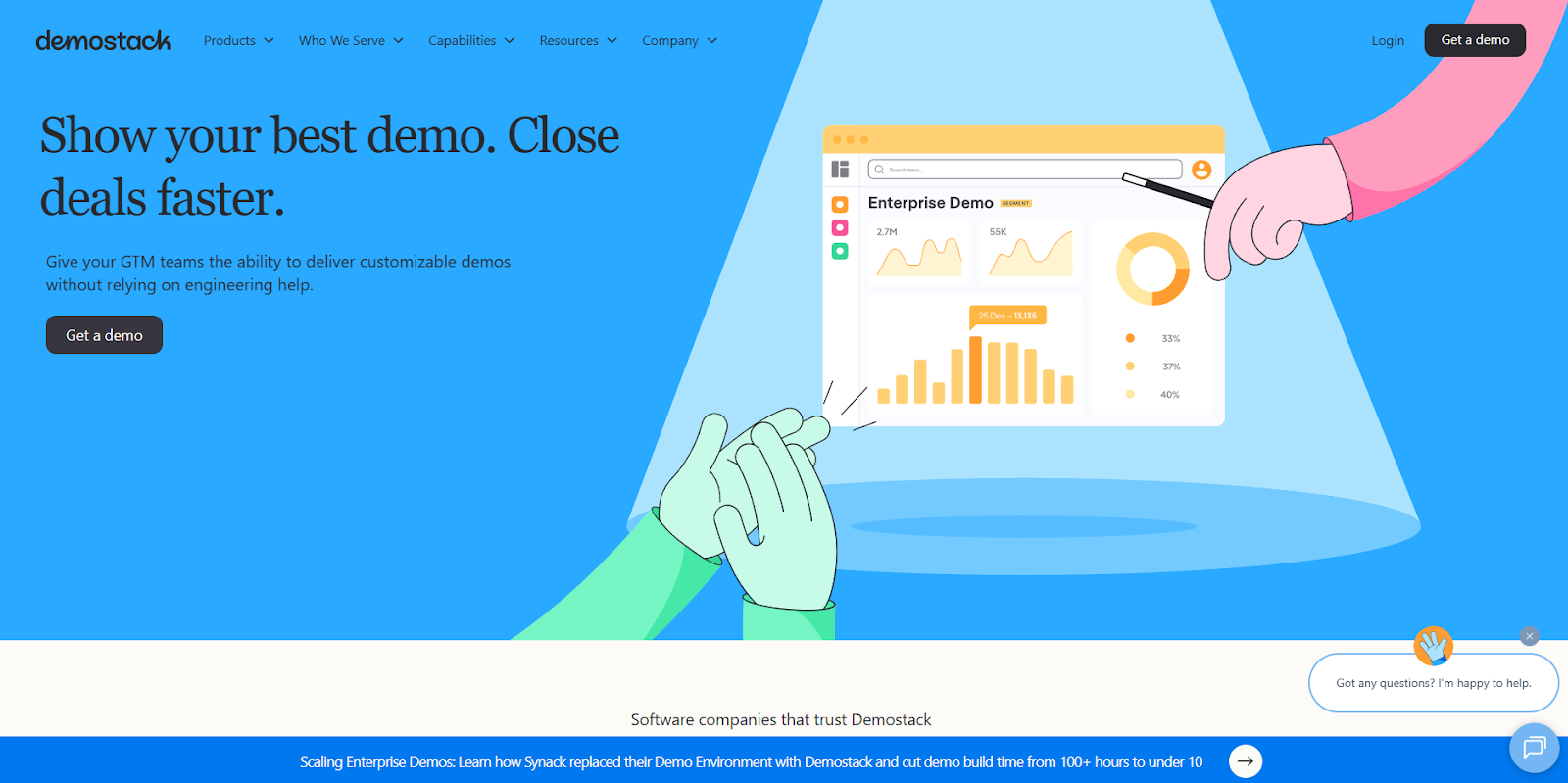
Gartner Rating: 4.6/5
Demostack enables sales and presales teams to create customizable, no-code demo environments that replicate real product interfaces for tailored presentations.
Key features
- Sandbox environments for building product demos without developer input.
- Quick customization for industry or persona-specific scenarios.
- Engagement tracking to analyze demo performance.
- Integration with CRM and enablement tools.
Pros
- Reduces setup time for demo environments.
- Enables scalable demo delivery across multiple deals.
Cons
- Focused primarily on demo delivery; limited CRM automation.
- May require coordination with engineering for complex setups.
Pricing: Custom pricing based on demo volume and integrations.
Best for
Presales and solution engineering teams needing to deliver high-quality, customized demos quickly without relying on technical resources.
8. Consensus
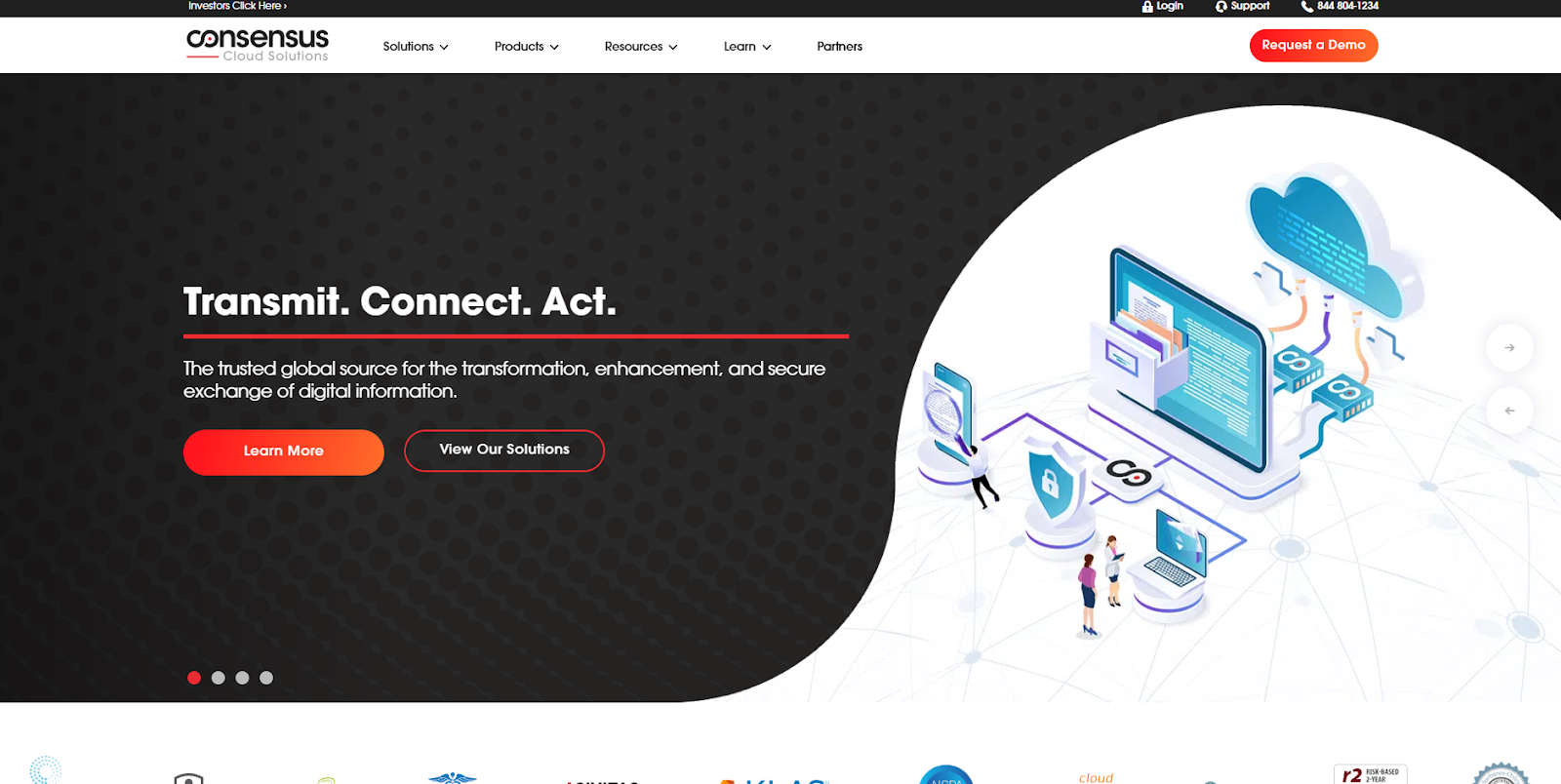
Gartner Rating: 4.8/5
Consensus is a buyer enablement and demo automation platform that allows sales teams to deliver on-demand, personalized product demos and track engagement data.
Key features
- Personalized, asynchronous demo creation.
- Real-time engagement tracking across buyer teams.
- Lead scoring based on demo interaction patterns.
- Integrations with CRM and marketing automation platforms.
Pros
- Helps maintain engagement with multiple stakeholders asynchronously.
- Provides visibility into buyer interest before live demos.
Cons
- Limited functionality outside demo automation and engagement tracking.
- Works best when paired with other CRM or RFP tools.
Pricing: Custom enterprise pricing based on demo volume and user seats.
Best for
B2B sales teams that want to scale personalized demo delivery and maintain buyer engagement throughout the mid-funnel stage.
9. Lavender
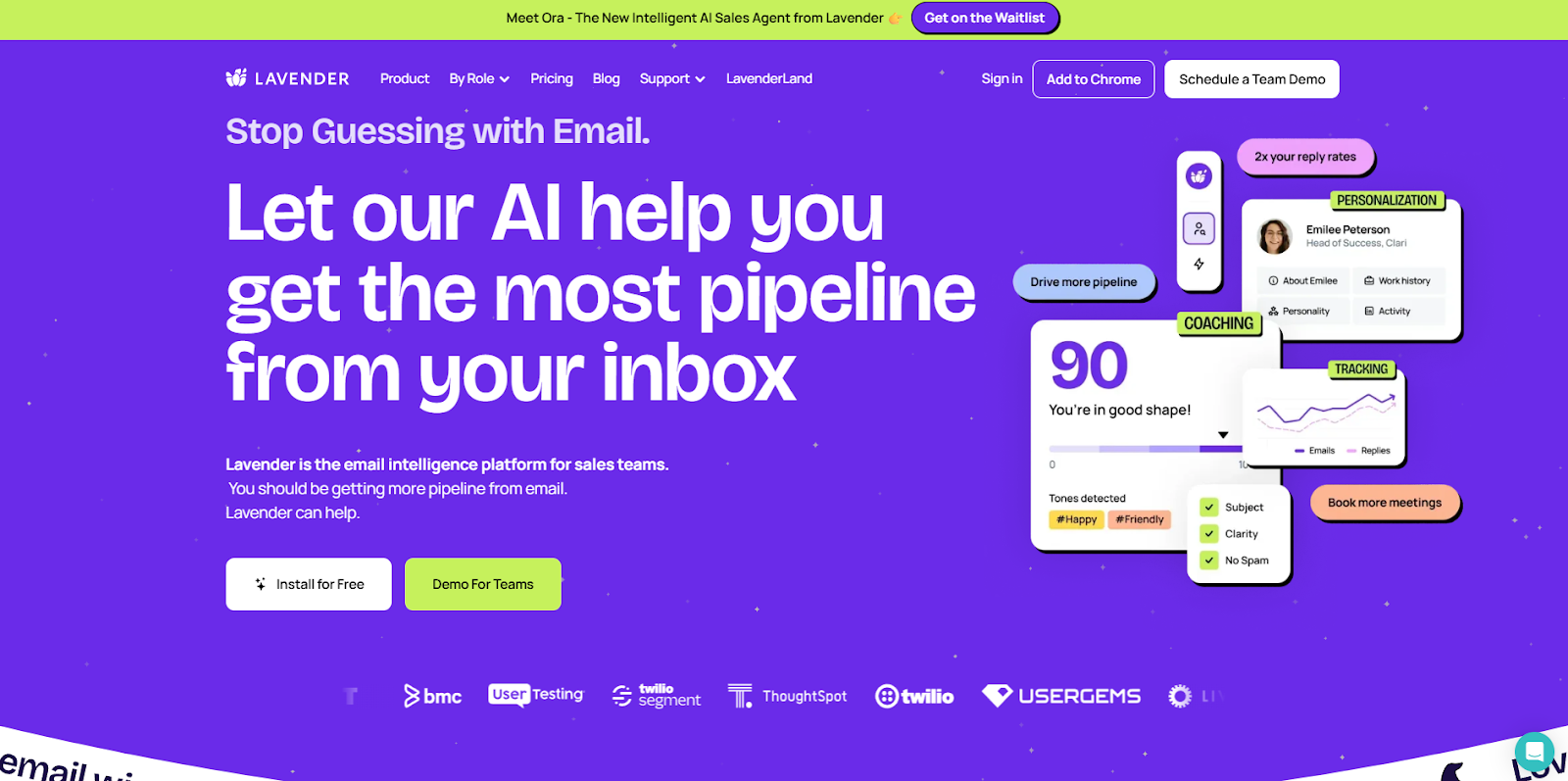
Gartner Rating: N/A
Lavender is an AI-based email assistant that analyzes and scores sales emails for clarity, tone, and personalization, helping improve outreach effectiveness.
Key features
- Real-time feedback on subject lines, tone, and structure.
- Personalization assistance using lead data and behavioral signals.
- Email scoring and improvement suggestions.
- Integration with email platforms like Gmail, Outlook, and HubSpot.
Pros
- Provides actionable feedback for faster, clearer outreach.
- Helps standardize email quality across sales teams.
Cons
- Limited functionality beyond outbound email optimization.
- Works best as an add-on, not a standalone pipeline tool.
Pricing: Free tier available; paid plans start at $27 per month.
Best for
SDRs and AEs looking to improve email personalization and maintain consistent outreach quality within existing sales workflows.
10. InsightSquared

Gartner Rating: 3.4/5
InsightSquared is an analytics and forecasting platform built to give revenue leaders visibility into pipeline health, deal velocity, and conversion patterns without requiring coding or BI expertise.
Key features
- Over 300 pre-built dashboards and forecasting reports.
- Predictive analytics to project revenue outcomes.
- Pipeline health monitoring with gap identification.
- Integration with major CRMs and sales tools.
Pros
- Provides structured insights into sales performance.
- Improves forecast accuracy through real-time reporting.
Cons
- Focuses on reporting; not a direct workflow automation tool.
- Custom configuration may be required for specific CRM setups.
Pricing: Enterprise-level pricing upon request.
Best for
Sales operations and revenue leadership teams that require detailed analytics to measure and manage pipeline velocity and forecast reliability.
Related: Building a Compeitive RFP Response Library
Implementation Tips and Pitfalls to Avoid
Adopting AI tools for pipeline acceleration isn’t just about plugging in new software. Without the right setup and adoption strategy, teams risk adding complexity instead of speed.
Tips for successful implementation
1. Start with clear objectives
Define what “pipeline acceleration” means in your context: shorter RFP turnaround, reduced proposal error rates, or higher conversion from late-stage deals. Align tool adoption with these measurable outcomes.
2. Audit and clean your data
AI tools are only as effective as the data they learn from. Before rollout, ensure CRM records, proposal libraries, and knowledge bases are accurate and de-duplicated. Clean inputs directly translate into cleaner AI outputs.
3. Pilot with high-impact teams
Rather than deploying across the organization at once, begin with presales or proposal teams handling large enterprise deals. A focused pilot creates early proof points and helps refine processes before scaling.
4. Embed AI into daily workflows
Adoption fails when tools live outside the systems reps already use. Choose solutions with native integrations into CRM, Slack, Teams, and SharePoint to ensure insights and drafts flow naturally into day-to-day work.
5. Establish feedback loops
Track metrics like draft cycle time, deal velocity, proposal accuracy, and win rates. Use these insights to refine not only the AI model but also team processes and collaboration habits.
Pitfalls to avoid
1. Overreliance on automation
AI should accelerate work, not replace human oversight. Strategic tailoring and subject matter expertise are still required for competitive proposals and demos.
2. Ignoring change management
Sales and presales teams often resist new tools. Training, leadership sponsorship, and clear ownership are critical to adoption.
3. Neglecting compliance and security
Enterprise proposals often involve sensitive technical or financial data. Ensure that tools support role-based access, audit trails, and SOC 2 compliance to protect information.
4. Spreading efforts across too many tools
Deploying multiple overlapping AI tools dilutes focus. Start with one or two solutions with the clearest link to pipeline velocity, then expand.
Related: RFP Automation Checklist for Sales Success
Conclusion
Accelerating the sales pipeline is no longer just about working harder; it’s about working smarter with the right AI tools. From predictive analytics and outreach automation to proposal response generation, AI equips enterprise sales and presales teams to cut cycle times, reduce errors, and align proposals with buyer priorities.
But generic AI tools alone won’t deliver the transformation decision-makers seek. Purpose-built platforms like Inventive AI’s AI-Powered RFP Response Software address the most resource-intensive pipeline bottlenecks: drafting proposals, aligning to evaluator criteria, and managing content freshness. With 10× faster first drafts, 95% accuracy, and 0% hallucination, Inventive AI empowers teams to improve throughput and increase win rates by up to 50%.
For CROs, VPs of Sales, and proposal managers, the message is clear: pipeline acceleration depends on combining automation with strategy. The companies that operationalize AI into their daily workflows will not just shorten sales cycles; they’ll close more enterprise deals, more consistently.
Here’s what our clients say
“Saved our Presales team a ton of time. Response quality is high, and the chatbot is useful for ad hoc responses.”
– Verified G2 reviewer, Solutions Engineering team
“It helps me save time by automating tasks in RFP creation and content management… speeds up document preparation and makes it easier to find information.”
– Verified G2 reviewer, Logistics & Supply Chain
Frequently Asked Questions (FAQs)
1. How do AI tools accelerate the sales pipeline?
AI tools accelerate the sales pipeline by automating repetitive tasks, surfacing the most promising leads, and generating first drafts for proposals. This shortens turnaround times and helps sales teams focus on closing deals instead of admin work.
2. Which AI tools are best for pipeline acceleration in enterprise sales?
Top tools include Inventive AI for proposal and RFP automation, Clari for forecasting, Gong for deal intelligence, and Outreach for engagement. Together, they cover the full sales cycle from lead prioritization to closing.
3. Can AI actually improve win rates, or just speed up processes?
Both. Research shows AI-driven sales teams can improve win rates by up to 30–50% when automation is applied to proposals, forecasting, and outreach. Faster cycles matter, but it’s the accuracy and evaluator alignment that really boost conversions.
4. How quickly do teams see ROI from AI pipeline tools?
Most organizations report efficiency gains within weeks, faster draft creation, reduced manual entry, and quicker follow-ups. Win-rate improvements are usually visible within 3–6 months of consistent use.
5. Is it safe to use AI tools for sensitive sales proposals?
Yes, provided you use enterprise-grade platforms. For example, Inventive AI guarantees 95% accuracy with 0% hallucination and never pulls content from the open web. All data remains within your secure, verified knowledge hub.


